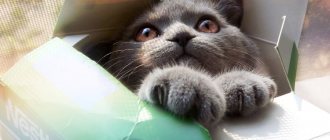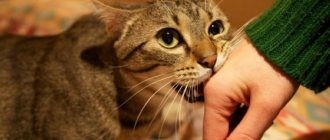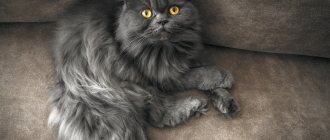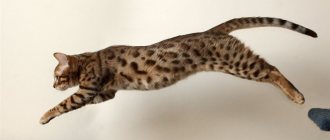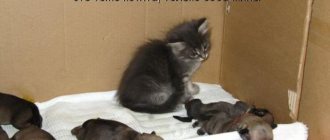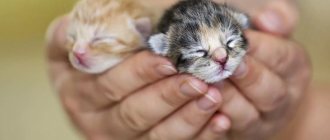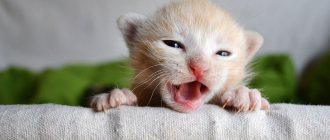Cats mean comfort, affection, purring, inexpressible tenderness and tenderness. And although cats are not always happy with children - they are too noisy and impetuous - the children themselves, as a rule, are delighted with them.
Petting and squeezing, playing and feeding, observing the habits of furry creatures - all this causes a storm of delight among the children. And how interesting it is to read books about cats!... After all, there your favorite pets come to life, adventures and amazing plot twists await them.
This selection contains the best books about cats for preschoolers. Happy reading!
Dina Sabitova “Tales about Martha”
Martha is a cheerful, playful kitten. She is curious and interested in everything: building sand castles, playing pirates and touching everything that is forbidden to touch. Sometimes she gets so involved in the game that she loses her parents. But Martha is not afraid, because she knows: mom and dad will definitely be found, because once they were already found.
There are two fairy tales in the book, and at the end there are several pages addressed to parents. There are practical tips on what and how to compose for a child, how to play with him, how to talk through and act out different life situations with children.
Recommended age: from 4 years.
The most famous cats are literary characters
One of the most recognizable and beloved characters in the world is the Cheshire Cat from Lewis Carroll's Alice in Wonderland.
Puss in Boots, although a fairy-tale character from the French writer Charles Perrault, is famous in the world like no other. The work, written in the seventeenth century, remains beloved by readers centuries later. Numerous animated and feature films were made based on it, and in 1912, composer Cesar Cui even wrote an opera.
The only animal whose philosophy is studied at universities is the hero of the satirical novel “The Everyday Views of Murr the Cat, Together with Fragments of the Biography of Kapellmeister Johannes Kreisler, Which Accidentally Survived in Waste Paper” (1819-1821) by Ernst Theodor Amadeus Hoffmann.
Murr is a direct descendant of Puss in Boots, whose full name is Hins von Ginzenfeld.
The Library Cat Who Shook the World is a 2008 book by Vicki Myron. This manuscript has been called an "encyclopedia of library life." The bitter story of the foundling Dewey and his mistress is real; the publishing house paid the author, the library director, $1.2 million for the right to publish.
One of the darkest literary heroes is the black cat from the work of the same name by Edgar Allan Poe. This short and creepy story describes the story of an alcoholic and his unfortunate pet, another animal's cruel revenge for its fellow.
London-based writer and musician James Bowen created the famous novel A Street Cat Named Bob and How He Saved My Life, published in the United States in 2013 and immediately becoming a global bestseller. In 2021, the book was made into a feature film. This autobiography of James tells about a difficult period of his life - heroin addiction. But one day he picked up a homeless red-haired Bob, who became the musician’s loyal friend and colleague.
Continuation of the story - “The World According to Bob” and “Bob the Cat: In the Name of Love.” “Bob the Extraordinary Cat” and “My Name is Bob” are children’s versions of the author’s books.
The cat that walked by itself, Pushkin's scientist cat, the mystical Hippopotamus - all these are examples of the most famous and well-known literary characters.
Olga Fadeeva “Kotofey”
A wonderful New Year's tale about the adventures of two cats. One of them was recently homeless and now really appreciates the comfort of home. Suddenly another pet appears in the house - a touching white kitten. This greatly worries the old-timer cat, and he decides to fight for his place in the house. The book shows the psychological moments of close communication: how a seasoned cat gradually develops sympathy for a small naive kitten, although initially he had a plan to teach the baby a lesson. Magic and everyday life are closely intertwined in this story. Recommended age: from 5 years.
Cats in Russian classics
Russian writers have repeatedly turned to the image of a cat in their works.
“Both day and night, the learned cat keeps walking around the chain...” This famous character from the preface to the poem “Ruslan and Lyudmila” by Alexander Sergeevich Pushkin is the prototype of Bayun, the main character of many Slavic fairy tales, which were told to the future poet by his nanny Arina Rodionovna in childhood.
Another Russian celebrity, the cat Vasily from the legendary novel “Monday Begins on Saturday” by the Strugatsky brothers, is also a science fiction writer’s interpretation of the image of the Slavic Bayun. This intellectual, who knows many fairy tales, parables, tales, legends and stories, is truly “a reader, a reaper, and a player of the pipe.” The philosopher, polyglot and sclerotic fell in love with all admirers of the works of Arkady and Boris Strugatsky.
The most mystical character not only in Russian, but also in world literature is the cat Behemoth from Mikhail Bulgakov’s novel “The Master and Margarita”.
Hippopotamus is a funny glutton; at the end of the novel he appears in the form of a sad page, forever doomed to wander with his terrible master, Woland. The writer's wife claims that the prototype of the hero was the pet Flushka, although literary critic Marietta Chudakova believes that Behemoth inherited his complacency from Hoffmann's Murr.
The Silver Age enriched Russian literature with Andrei Bely’s novel “Kitten Letaev” and Igor Severyanin’s poems “Kitty, dear child...”.
In Russian literature and painting, starting from the second half of the nineteenth century, there has been simply cat-like abundance. This is “Tales of the Purring Cat” by N.P. Wagner, werecats from the stories of N.V. Gogol, Alexander Kuprin’s favorite Yu-Yu, works by A.P. Chekhov and N.S. Leskov, poems by Afanasy Fet, Alexander Blok, Sergei Yesenin, Vladislav Khodasevich, Marina Tsvetaeva and Teffi.
Modern authors do not forget about the image of an animal guide to the world of speculation and mysticism. A striking example of this is Victoria Tokareva’s story “Cat on the Road”, works by Viktor Pelevin, Lyudmila Ulitskaya and Eduard Uspensky.
Melanie Watt "Chester's Masterpiece"
Chester is a narcissistic cat. He believes that everyone should look only at him. Melanie Watt, his owner, is trying to write a book about a mouse, but Chester takes a red felt-tip pen and makes his own adjustments. Or rather, he believes that the mistress is only hindering him; even without her, he would have written an outstanding masterpiece.
An obnoxious but charming cat paints and edits the pages of a book. Now Melanie will just have to write a book about Chester! True, for his pranks at the end of the story, Chester will be depicted in a ridiculous clown costume.
The book unobtrusively teaches readers to listen to constructive criticism. By the way, the previous two books – “Chester” and “Chester the Superstar” – were also a great success among readers.
Recommended age: from 5 years.
Detectives with cats
Even the detective genre could not do without cats.
German writer of Turkish origin Akif Pirinci is famous for his “Cat” series, in which human subjects are stylized as animals. The main detective is a cat named Francis.
Lillian Jason Brown's series of detective novels, The Cat Who..., uses autobiographical elements. And it tells the story of the journalist Qwilleran, who picked up two orphaned Siamese pets - the cat Coco and the kitty Yum-Yum. The main character investigates the mysterious disappearances of their former owners. There are more than 30 books in the series, including “The Cat Who Loved Brahms”, “The Cat Who Read from Right to Left” and others.
In Elena Mikhalkova's ironic detective stories, the main characters are also cats. “Cats should not be offended,” “Black Poodle, Red Cat, or a Wedding with Obstacles” and her other books use many of the personal experiences of the author, the owner Stepan, picked up on the street, and the fiery Maine Coon Makar.
Foreign detective "Catnapping" by Carol Nelson Douglas tells the story of Louis the cat, who loves secrets and riddles, who helps in the investigation of a mysterious murder at a book fair.
Cheerful
The greatest respite for cats, of course, is in children's poems, counting rhymes and lullabies. Already Vasily Zhukovsky wrote a nice little thing in 1814: “Bald cat, poor cat! / Why did he jump out the window? / There was a copper basin on the window, / A basin with a clay bottom!” But the main masterpieces of children's poems were created in the twentieth century. All the masters of the genre were noted: Agnia Barto, Boris Zakhoder, Samuil Marshak (both his own and those translated from English are good), Sergei Mikhalkov, Yunna Morits, Andrei Usachev, Daniil Kharms, Sasha Cherny...
Vladimir Konashevich. Illustration for the poem by Samuil Marshak “The boat floats, floats”
Vladimir Konashevich. Illustration for the poem by Samuil Marshak “The boat floats, floats”
Vladimir Konashevich. Illustration for the poem by Samuil Marshak “The boat floats, floats”
In the second half of the twentieth century, cats penetrated from children's books into cartoons: Grigory Oster (“A Kitten Named Woof”), Vladimir Suteev (“Who Said Meow?”), Eduard Uspensky (“Uncle Fyodor, the Dog and the Cat”) and etc.
Let's not forget cats in prose: the cat Basilio from the adventures of Buratino by Alexei Tolstoy, however, is again an anthropomorphic character. In 1872, “Tales of the Purring Cat” by Nikolai Wagner was published, where the story is told on behalf of the venerable Cat (and the tales are so complex that they were written more for adults than for children). It was necessary to wait for Paustovsky so that in his “Cat the Thief” he would finally describe the animal as a normal naturalist, in the spirit of Seton-Thompson. And Kuprin in 1927 wrote a memoir story “Yu-Yu”, about his beloved cat.
Cat Matroskin. Still from the cartoon “Three from Prostokvashino” (1978)
Igor Oleynikov. Illustration for the poem by Daniil Kharms “The Amazing Cat”
Science fiction also cannot do without cats: Kira Bulychev has a story “A Mind for a Cat,” and in 2004 Russian science fiction writers even published an anthology “Man to Man is a Cat,” where there are writers Divov, Lukyanenko, Zorich and Kaganov.
Novels and special editions
- Dreams and Visions of the Butterfly (special edition, 2018)
- Echo of Thunderstar (novel, 2017)
- Life of the Shadow Star (short story, 2019)
- Cloudstar's Journey (short story, 2015)
- Mapleshade's Revenge (short story, 2015)
- Pinestar's Choice (short story, 2017)
- Curse of Goosefeather (short story, 2015)
- Revenge of the Star Beam (special edition, 2013)
- The Secret of Yellowfang (special edition, 10/09/2012)
- Meteor's Promise (special edition, 07/05/2011)
- The Blue Star Prophecy (special edition, 07/04/2009)
- Spottedleaf's Heart (short story, 2017)
- Furytail's Debt (novel, 2019)
Cycle "Warriors"
Get wild! (2003)
The life of the domestic kitten Ryzhik changed on the day when he first entered the forest where clans of wild cats live and fight.
Is Ryzhik worthy to become a ThunderClan warrior? The domestic kitten will actually have to prove his courage and bravery.
Dangerous adventures, true friends, irreconcilable enemies... Ryzhik deserves to be wild!
Fire and Ice (2003)
After defeat in the inter-clan war, the Wind Tribe was expelled from its territory. From now on, balance and order in the forest are disrupted!
Bluestar cannot come to terms with such injustice: Graystripe and Fireheart go in search of the WindClan cats.
But what to do with the traces found on the borders of the tribe? Who threatens the peaceful life of Blue Star?
You can part with your dreams of a peaceful and carefree life... Everyone is concerned about the survival of kittens in winter.
Forest of Secrets (2003)
In spring, a new danger came to the forest: wild cats could die during a flood.
Due to the fact that people poisoned the river, all the fish became unfit for food. Graystripe and Fireheart come to the aid of the little kits and help RiverClan get food.
Hunger embitters the cats - a new battle is just around the corner...
Raging Element (2004)
A fire is burning in the territory where ThunderClan lives. Will the herald Fireheart be able to lead the tribe out of the fire and avoid losses at the same time?
And, probably, Fireheart should look around more often: the insidious Claw is preparing an attack...
A streak of bad luck begins in Fireheart's life.
- Fury of the Claw (novella, 2014)
- Finding Home (manga, 2008)
Dangerous Path (2004)
As soon as the tribes of wild cats dealt with the fire, a new disaster came to the forest.
A pack of ferocious dogs that escaped from dog catchers settles in the territory of ThunderClan. They are careful and careful: none of the cats should reveal their secret hiding place.
The Star Ancestors warn the Thundercats that evil lurks in the forest...
- Scourge: Path to Power (manga, 2008)
Battle for the Forest (2004)
Only in the sanctuary, hidden from prying eyes high in the rocks, can you receive the gift of nine lives.
It's time for Firestar, as the leader of the glorious ThunderClan, to hit the road.
Terrible, bloody times are approaching. And Firestar, having received a warning of impending disaster, must think about protecting his tribe...
- Escape from the Forest (manga, 2008)
- Firestar Mission (special edition, 2007)
- Main Choice (manga, 2009)
- Disturbed Peace (manga, 2009)
- To the Rescue of the Tribe (manga, 2010)
- Heart of a Warrior (manga, 2010)
- The Fate of SkyClan (special edition, 2010)
Edifying
Even when we are talking about completely ordinary, real animals, without any demonic or supernatural powers, writers cannot resist giving them human traits. Cats become the personification of vices, such as greed, gluttony, deceit, and cunning. Let us remember the winged “And Vaska listens and eats” from Krylov’s fable “The Cat and the Cook”. By the way, in the poems composed around 1812, contemporaries saw a satire on Napoleon’s desire for world domination. And his “The Cat and the Nightingale” of 1824 (“...Thin songs of the Nightingale in the claws of the Cat”) is about censorship in the press. “The Pike and the Cat” (“...It will be trouble if the shoemaker starts baking pies”) is generally about Admiral Chichagov and his failures.
Alexander Deineka. Cat and cook. 1922
Evgeny Rachev. Cat and Nightingale. 1961
Georgy Narbut. Pike and cat. 1909
All fans of the genre used the image of a cat in their fables - Ivan Khemnitser, Alexander Sumarokov, Ivan Dmitriev, Vasily Zhukovsky, Vasily Pushkin, Leo Tolstoy (in fairy tales) and Sergei Mikhalkov. And it all started, of course, with Aesop and La Fontaine.
Mysterious
A special place among rhyming cats in Russian culture is occupied by the plot “How mice buried a cat.” Already in the 1690s, in the earliest collection of Russian proverbs, the proverb “Mice are dragging a cat to the graveyard” is found, then it takes the form “Mice are burying a cat” and “Mice are burying a cat.” Many popular prints on this plot have been preserved, which are accompanied by a long rhyming text (“A fable in the faces was found in old rooms, wrapped in black trepits, like mice bury a cat, see off their enemy, give the last honor to him...”, etc.). The engraving became such a striking sign of the 18th century that in “The Captain’s Daughter” Grinev sees it in the house of Captain Mironov, Roslavlev looks at it at the inn in Mikhail Zagoskin’s novel, and in Lazhechnikov it hangs in the firecracker’s room in “The Ice House”.
How mice buried a cat. Splint. OK. 1725
How mice buried a cat. Splint. XVIII century
Scientists argued for a long time what this engraving illustrated: the prevailing opinion was that this was some kind of satire on the burial of Peter the Great, invented by the Old Believers, and in the offensive nicknames of other characters in the popular print they recognized his associates. There is still no final opinion on the meaning of the popular print. However, there is a version that this is how the plot from Aesop’s fable, in which a cat pretended to be dead in order to eat mice, was refracted on Russian soil.

